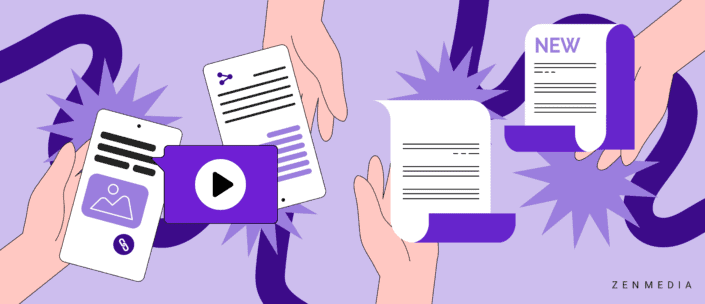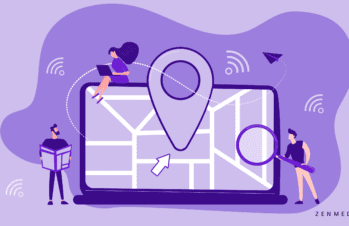The debate between whether you should prioritize physical or digital marketing shouldn’t even be a debate. This isn’t an either/or situation—and in fact, it hasn’t been for years!
Good PR and marketing always meet buyers where they are—whether that’s strategically placed signage in the subway or a well-timed Instagram ad that pops up just as they’re scrolling through their feed.
At Zen Media, we’ve long recognized that the magic happens in the overlap, in the seamless integration of digital and physical realms, to create a marketing strategy that’s not just innovative but genuinely impactful.
Embracing a Holistic Marketing Philosophy
Cultivate Understanding and Empathy
Start with empathy. Dive deep into understanding your audience, what drives them, and what challenges they face. This foundational step allows you to tailor your marketing strategies to not only align with their habits but also resonate with their emotions. Speak to your audience in their language and meet them in spaces, both physical and digital, where they’re most comfortable and receptive.
Leverage Technology to Enhance Human Connections
While technology offers endless opportunities to reach and engage with your audience, it should never replace the human element at the heart of your brand. Use digital tools to supplement, not substitute, the personal connections that build loyalty and trust. Whether through engaging content on social media or personalized digital experiences, the goal is to foster a sense of community and belonging among your audience.
Related Reading: Putting EI into AI: Emotion AI and Personalization Marketing
Leverage Data-Driven Insights for Targeted Engagement
Incorporate data analytics into your strategy to understand where your audience spends their time and how they interact with your brand across both digital and physical realms. This informed approach allows for more targeted and effective engagement strategies, ensuring you connect with your audience when they are most receptive. Remember, it’s not just about reaching them at the right place but also at the right moment in their consumer journey.
Balance Innovation with Intuitive Understanding
Innovation is crucial for staying ahead in the fast-paced marketing world, but it should be balanced with an intuitive understanding of your audience’s evolving needs and behaviors. Keep a pulse on market trends and consumer behavior to anticipate where your audience is headed next. This foresight is invaluable in crafting strategies that not only meet the audience where they are today, but also where they will be tomorrow.
Blending Digital and Physical Marketing Strategies
Create Seamless Omnichannel Experiences
To truly resonate with your audience, it’s essential to maintain a unified brand message across all platforms, from the digital realms of social media to the tangible touchpoints of in-store displays. This consistency not only reinforces brand recognition but also strengthens trust with your audience, creating a reliable and familiar presence no matter where they encounter your brand.
By crafting campaigns that effortlessly transition from online advertisements to real-world events, brands can create a cohesive journey for their consumers. This approach not only amplifies the impact of both digital and physical engagements but also fosters a deeper connection with your audience by providing a multi-dimensional brand experience that is both engaging and memorable.
A prime example of this strategy in action is our Capital One Turkey Trot campaign. Before the event, targeted digital marketing efforts asked participants of the YMCA Dallas Turkey Trot to dress like turkeys. The result? Forty thousand people participated, breaking the Guinness World Record for most people dressed as turkeys for a single event, garnering Capital One and the YMCA national press coverage.
Leverage Data for Personalization
By harnessing customer data gleaned from both online interactions and physical engagements, brands can craft marketing efforts that are not just targeted but deeply personalized. This approach transforms the customer experience, making individuals feel uniquely valued and seen, which in turn significantly boosts engagement and loyalty.
Using the data collected, brands can adjust their user experience and marketing touchpoints to provide maximum impact, optimizing every touchpoint to meet the audience’s evolving needs and preferences. The end goal is a highly tailored experience that resonates on a personal level, fostering a sense of connection and loyalty that transcends the transactional.
Enhance Physical Experiences with Digital Tools
By embedding interactive technologies like QR codes in retail spaces, brands can unlock new dimensions of engagement. These digital gateways encourage customers to explore exclusive online content or access special promotions, effectively bridging the gap between the physical and digital realms.
Plus, you can always create a digital version of your in-person event and use it to magnify your event’s impact and reach. Live streaming, the creation of event-specific applications, or the strategic use of social media not only engages those already in attendance but also draws in a global audience.
This dual engagement strategy ensures that the experience resonates beyond the confines of the event itself, creating a comprehensive ecosystem where physical and digital interactions complement and enhance each other, broadening the brand’s audience and deepening the connection with its community.
Foster Community Through Both Channels
By engaging across platforms, brands can cultivate a sense of belonging and community that cultivates both online followers and embraces physical patrons. Encouraging online followers to participate in in-person events, and vice versa, using physical engagements as a springboard for digital interaction, creates a dynamic ecosystem where each feeds into and amplifies the other.
That’s exactly what happened when we took our campaign with Chase “mobile.” The Chase BizMobile, a 28-foot trailer turned mobile business consultancy, served as a physical embodiment of Chase’s support for small businesses. Launched during Detroit Start-Up Week, the BizMobile traveled across the country, making stops at co-working spaces, start-up weeks, and festivals. This on-the-ground presence allowed Chase to directly engage with small business owners, offering them invaluable resources on marketing, access to capital, and expense management.
The physical interactions fostered by BizMobile created a tangible sense of community among participants, providing them with a platform to share experiences, challenges, and successes. Through a strategic combination of local micro-influencers and national press coverage, with notable appearances by figures like Marcus Lemonis, the campaign generated significant buzz online.
And once the tour was over? Amplification.
Regular updates, events, and content that invite audience participation keep the conversation flowing and the community engaged. The more consumers see your brand, the more likely they are to develop frequency bias—meaning you’re more likely to be their default choice.
Embrace Flexibility and Innovation
A commitment to agility enables brands to respond effectively to evolving consumer behaviors and emerging trends, ensuring the relevance and effectiveness of marketing efforts. This means being super adaptable with your strategies because what works today might not cut it tomorrow. Consumer behaviors and trends are always on the move, and sticking to the same old plan just because it worked once is a surefire way to get left behind. Think of it as keeping your marketing strategy on its toes—always ready to pivot based on the latest feedback or a sudden shift in how your audience is vibing.
And don’t be afraid to shake things up with a bit of experimentation. Trying out new technologies or taking a leap with some out-of-the-box marketing ideas can really pay off.
We’re all about creating connections that stick, whether it’s through a screen or face-to-face. Ready to make your brand unforgettable? Hit us up, and let’s get creative together.






